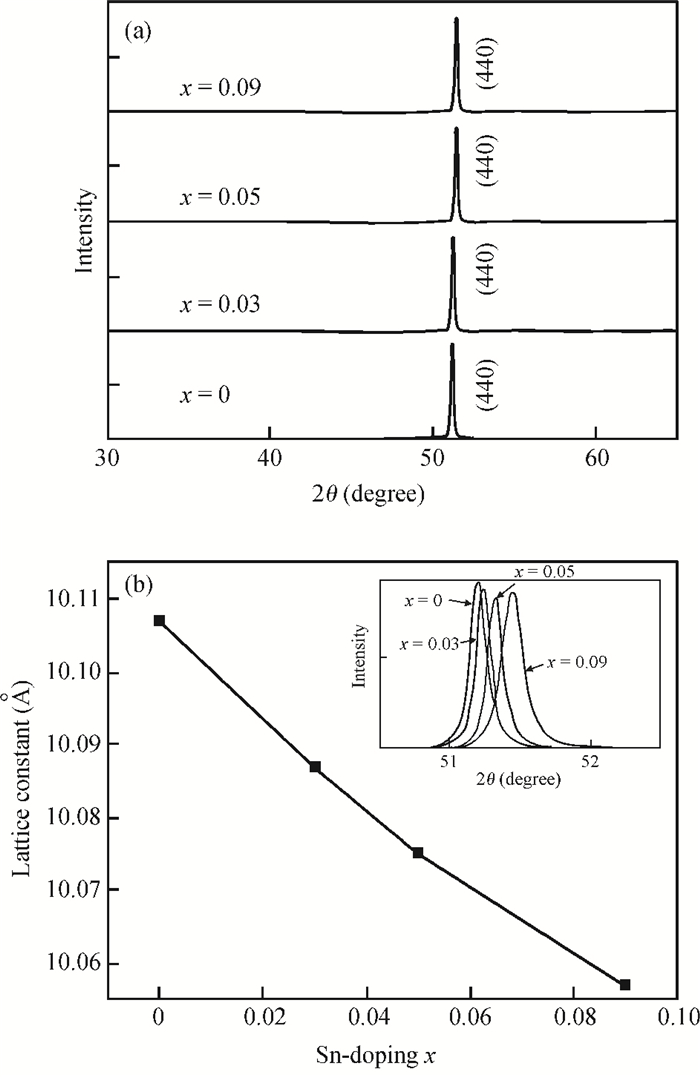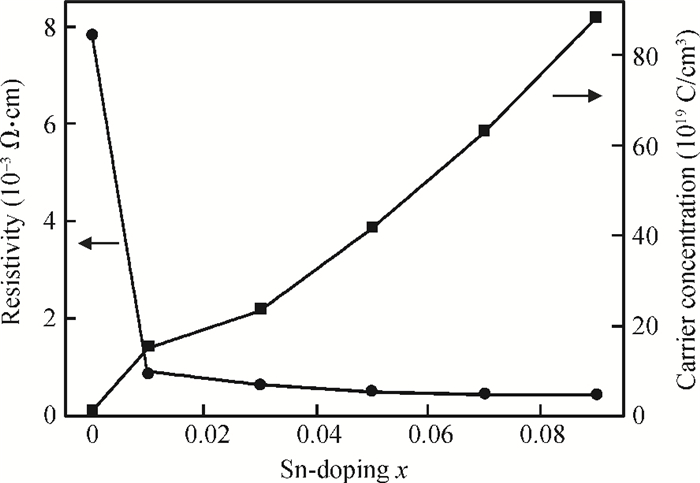| Citation: |
Pengfei Xing, Yanxue Chen, Shaohua Sun. Effect of Sn-doping on the structural, electrical and magnetic properties of (In0.95-xSnxFe0.05) 2O3 films[J]. Journal of Semiconductors, 2013, 34(2): 023002. doi: 10.1088/1674-4926/34/2/023002
****
P F Xing, Y X Chen, S H Sun. Effect of Sn-doping on the structural, electrical and magnetic properties of (In0.95-xSnxFe0.05) 2O3 films[J]. J. Semicond., 2013, 34(2): 023002. doi: 10.1088/1674-4926/34/2/023002.
|
Effect of Sn-doping on the structural, electrical and magnetic properties of (In0.95-xSnxFe0.05) 2O3 films
DOI: 10.1088/1674-4926/34/2/023002
More Information
-
Abstract
Room-temperature ferromagnetism was observed in (In0.95-xSnxFe0.05)2O3 (x=0-0.09) films deposited by pulsed laser deposition. XRD results give a direct proof that both Sn and Fe ions have been incorporated into the In2O3 lattice. The carrier concentration in the films is obviously increased by the Sn-doping, while the ferromagnetic properties are rarely changed. We think that in our Fe-doped In2O3 films, the oxygen vacancy-related bound magnetic polaron model, rather than the carrier-mediated RKKY coupling, is the main mechanism for the observed ferromagnetism. -
References
[1] Dietl T, Ohno H, Matsukura F, et al. Zener model description of ferromagnetism in zinc-blende magnetic semiconductors. Science, 2000, 287:1019 doi: 10.1126/science.287.5455.1019[2] Sharma P, Gupta A, Rao K V, et al. Ferromagnetism above room temperature in bulk and transparent thin films of Mn-doped ZnO. Nat Mater, 2003, 2:673 doi: 10.1038/nmat984[3] Ueda K, Tabata H, Kawai T, Magnetic and electric properties of transition-metal-doped ZnO films. Appl Phys Lett, 2001, 79:988 doi: 10.1063/1.1384478[4] Matsumoto Y, Murakami M, Shono T, et al. Room-temperature ferromagnetism in transparent transition metal-doped titanium dioxide. Science, 2001, 291:854 doi: 10.1126/science.1056186[5] Ogale S B, Choudhary R J, Buban J P, et al. High temperature ferromagnetism with a giant magnetic moment in transparent Co-doped SnO2-δ. Phys Rev Lett, 2003, 91:77205 doi: 10.1103/PhysRevLett.91.077205[6] Coey J M D, Douvalis A P, Fitzgerald C B, et al. Ferromagnetism in Fe-doped SnO2 thin films. Appl Phys Lett, 2004, 84:1332 doi: 10.1063/1.1650041[7] Fitzgerald C B, Venkatesan M, Douvalis A P, et al. SnO2 doped with Mn, Fe or Co:room temperature dilute magnetic semiconductors. J Appl Phys, 2004, 95:7390 doi: 10.1063/1.1676026[8] Griffin K A, Pakhomov A B, Wang C M, et al. Intrinsic ferromagnetism in insulating cobalt doped anatase TiO2. Phys Rev Lett, 2005, 94:157204 doi: 10.1103/PhysRevLett.94.157204[9] Zhang Z H, Wang X, Xu J B, et al. Evidence of intrinsic ferromagnetism in individual dilute magnetic semiconducting nanostructures. Nat Nanotechnol, 20094:523 doi: 10.1038/nnano.2009.181[10] Colis S, Bouaine A, Moubah R, et al. Extrinsic ferromagnetism in epitaxial Co-doped CeO2 pulsed laser deposited films. J Appl Phys, 2010, 108:053910 doi: 10.1063/1.3481026[11] Liu X J, Zhu X Y, Song C, et al. Intrinsic and extrinsic origins of room temperature ferromagnetism in Ni-doped ZnO films. J Phys D:Appl Phys, 2009, 42:035004 doi: 10.1088/0022-3727/42/3/035004[12] Wang Q, Sun Q, Jena P. Carrier-mediated ferromagnetism in N codoped (Zn, Mn)O (10) thin films. Phys Rev B, 2004, 70:052408 doi: 10.1103/PhysRevB.70.052408[13] Akai H. Ferromagnetism and its stability in the diluted magnetic semiconductor (In, Mn)As. Phys Rev Lett, 1998, 81:3002 doi: 10.1103/PhysRevLett.81.3002[14] Coey J M D, Venkatesan M, Fitzgerald C B. Donor impurity band exchange in dilute ferromagnetic oxides. Nat Mater, 2004, 4:173 http://adsabs.harvard.edu/abs/2005NatMa...4..173C[15] Chopra K L, Major S, Pandya D K. Transparent conductors—a status review. Thin Solid Films, 1983, 102:1 doi: 10.1016/0040-6090(83)90256-0[16] Hong N H, Sakai J, Huong N T, et al. Room temperature ferromagnetism in laser ablated Ni-doped In2O3 thin films. Appl Phys Lett, 2005, 87:102505 doi: 10.1063/1.2041822[17] Philip J, Punnoose A, Kim B I, et al. Carrier-controlled ferromagnetism in transparent oxide semiconductors. Nat Mater, 2006, 5:298 doi: 10.1038/nmat1613[18] Raebiger H, Lany S, Zunger A. Control of ferromagnetism via electron doping in In2O3:Cr. Phys Rev Lett, 2008, 101:027203 doi: 10.1103/PhysRevLett.101.027203[19] Panguluri R P, Kharel P, Sudakar C, et al. Ferromagnetism and spin-polarized charge carriers in In2O3 thin films. Phys Rev B, 2009, 79:165208 doi: 10.1103/PhysRevB.79.165208[20] Hakimi A, Blamire M G, Heald S M, et al. Donor-band ferromagnetism in cobalt-doped indium oxide. Phys Rev B, 2011, 84:085201 doi: 10.1103/PhysRevB.84.085201[21] Xing P F, Chen Y X, Yan S S, et al. High temperature ferro-magnetism and perpendicular magnetic anisotropy in Fe-doped In2O3 films. Appl Phys Lett, 2008, 92:022513 doi: 10.1063/1.2834369[22] Xing P F, Chen Y X, Yan S S, et al. Tunable ferromagnetism by oxygen vacancies in Fe-doped In2O3 magnetic semiconductor. J Appl Phys, 2009, 106:043909 doi: 10.1063/1.3202287[23] Xing Pengfei, Chen Yanxue, Tang Minjian, et al. Room-temperature anisotropic ferromagnetism in Fe-doped In2O3 heteroepitaxial films. Chin Phys Lett, 2009, 26:117503 doi: 10.1088/0256-307X/26/11/117503[24] Lu Z, Hsu H, Tzeng Y, et al. Carrier-mediated ferromagnetism in single crystalline (Co, Ga)-codoped ZnO films. Appl Phys Lett, 2009, 94:152507 doi: 10.1063/1.3120557 -
Proportional views






 DownLoad:
DownLoad:
















